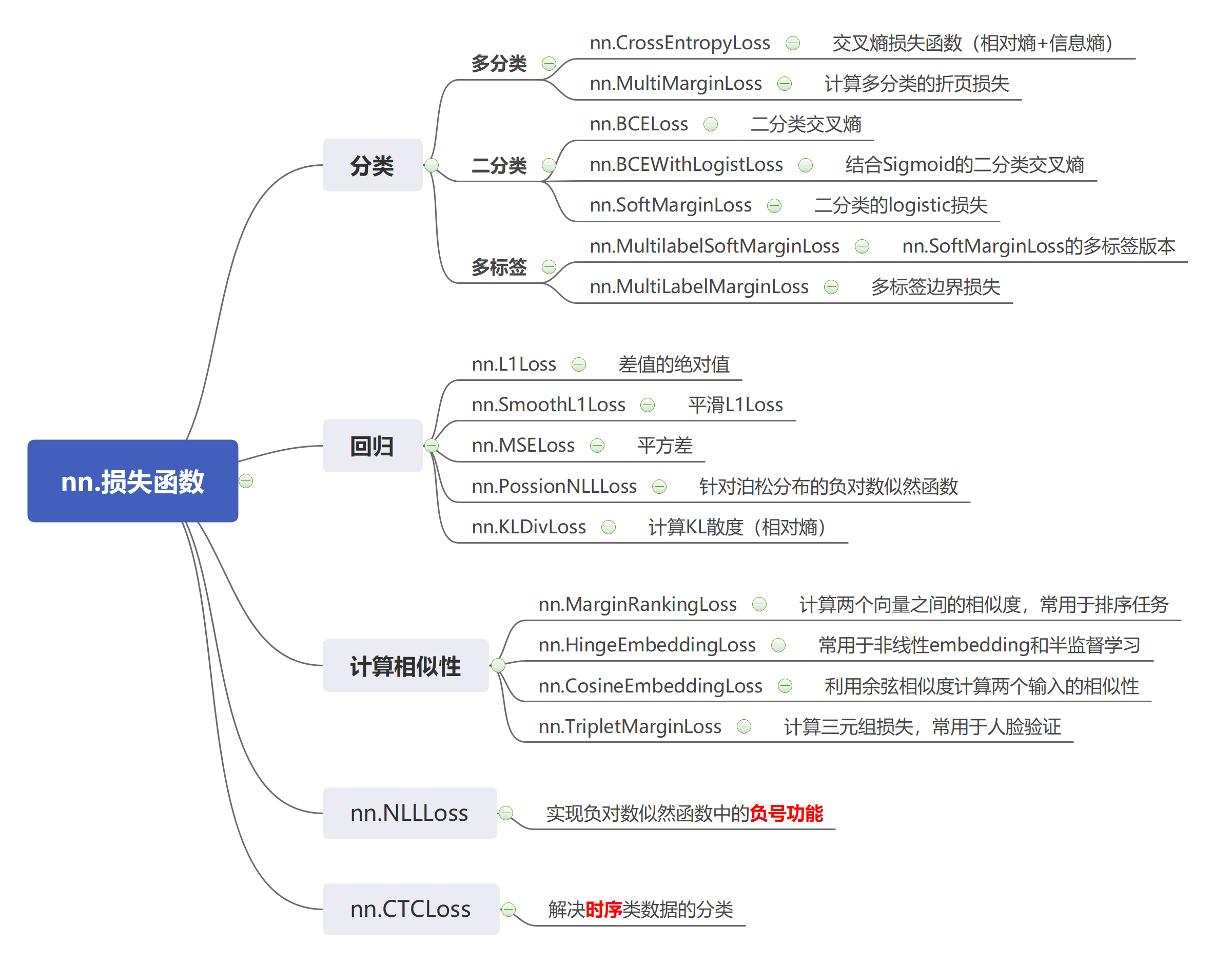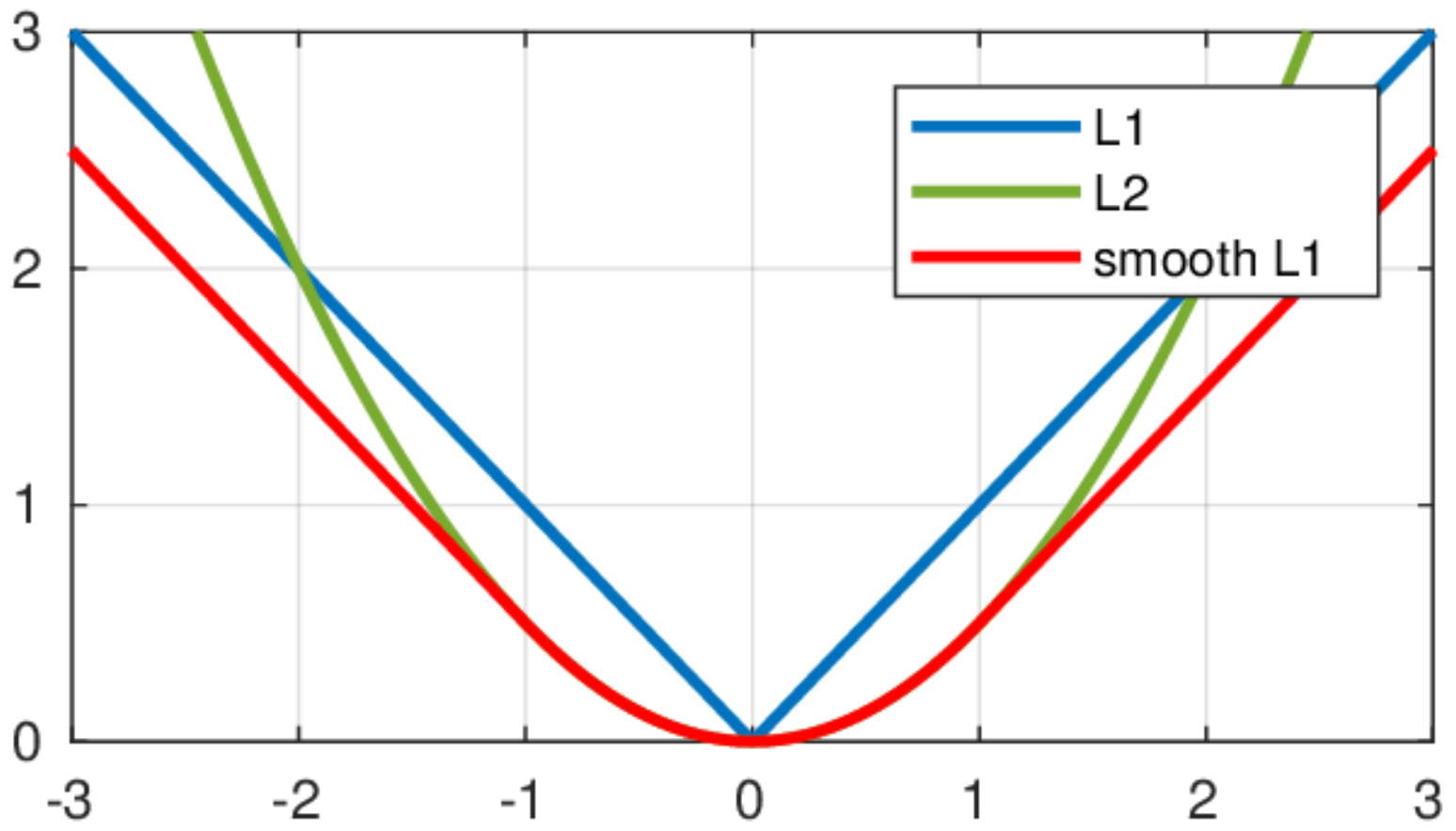| 本节简单总结torch.nn封装的18种损失函数。【文中思维导图采用MindMaster软件,Latex公式采用在线编码器】 |
目录

1.nn.CrossEntropyLoss()交叉熵损失函数
loss_f = nn.CrossEntropyLoss(weight=None, ignore_index=-100, reduction='mean')
inputs = torch.tensor([[1, 2], [1, 3], [1, 3]], dtype=torch.float)
target = torch.tensor([0, 1, 1], dtype=torch.long)
loss = loss_f(inputs, target)
# 参数:
# weight:设置各类别的loss的权重,(防止类别数目不平衡)e.g. weights = torch.tensor([1, 2], dtype=torch.float) 两个类别
# ignore_index: 忽略某个类别
# reduction:计算模式 1.'None':逐元素计算,返回张量;2.'sum':所有元素求和,返回标量;3.'mean':加权平均,返回标量
nn.CrossEntropyLoss是nn.LogSoftmax与nn.NLLLoss的结合,公式为:
\[loss\left ( x,class \right )= -\log{\left ( \frac{\exp x\left [ class \right ] }{\sum_{j} \exp x\left [ j \right ] } \right ) }=weight\left [ class \right ] \left ( -x\left [ class \right ] +\log{\sum_{j} \exp x\left [ j \right ]} \right ) \]
上述公式的由来:交叉熵 = 信息熵 + 相对熵
- 信息熵:描述整个概率分布上事件的不确定性
\[H\left ( p \right ) =E_{x\sim p} \left [ I\left ( x \right ) \right ] =\sum_{i}^{N} p\left ( x_{i} \right )\left ( -\log{p\left ( x_{i} \right )} \right ) \]
- 相对熵(KL散度):描述两个分布之间的距离
\[D_{KL}\left ( P,Q \right ) =E_{x\sim p} \left [ \log{\frac{P\left ( x \right ) }{Q\left ( x \right ) } } \right ]=\sum_{i}^{N} P\left ( x_{i} \right )\left [ \log{P\left ( x_{i} \right )}- \log{Q\left ( x_{i} \right )} \right ] \]
- 交叉熵
\[H\left ( P, Q \right ) =D_{KL}\left ( P,Q \right ) +H\left ( p \right ) =-\sum_{i}^{N} P\left ( x_{i} \right )\left [- \log{Q\left ( x_{i} \right )} \right ] \]
其中 \(P\) 为真实数据分布,\(H(P)\) 在优化时为常数,故而 \(H\left ( P,Q \right ) \longrightarrow D_{KL}\left ( P,Q \right )\)。实际代码中, \(P\) 即为标签,\(Q\) 为数据经过网络得到的分布,即取\(softmax\)。
2.nn.BCELoss()二分类交叉熵损失函数
注意:输入值必须在[0,1]之间,表示一个分布。
loss_f = nn.BCELoss(weight=None,reduction='mean')
inputs = torch.tensor([[1, 2], [2, 2], [3, 4], [4, 5]], dtype=torch.float)
target = torch.tensor([[1, 0], [1, 0], [0, 1], [0, 1]], dtype=torch.float)
loss = loss_f(inputs, target)
3.nn.BCEWithLogitsLoss()结合Sigmoid的二分类交叉熵损失函数
loss_f = nn.BCEWithLogitsLoss(weight=None, reduction='mean', pos_weight=None)
# 参数:
# pos_weight:正样本(标签为1)的权值

4.nn.L1Loss
计算inputs与label之间差值的绝对值
\[l_{i}=\left | x_{i}-y_{i } \right | \]
5.nn.MSELoss
计算inputs与label之间的平方差
\[l_{i}=\left ( x_{i}-y_{i } \right ) ^{2} \]
6.nn.SmoothL1Loss
平滑的L1Loss,由图2红色线与蓝色线对比可以看出。通过下面的公式我们也可以知道,SmoothL1损失结合了L1和MSE两者的优点。
\[\left\{\begin{matrix} loss=\frac{1}{n}\sum_{i}^{n} z_{i} \\z_{i}=\begin{cases} \frac{1}{2} \left ( x_{i}-y_{i } \right ) ^{2} & \text{ if } \left | x_{i}-y_{i }< 1\right | \\ \left | x_{i}-y_{i }\right |-0.5 & \text{others} \end{cases} \end{matrix}\right.\]